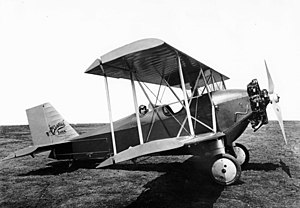The Curtiss Model 41 Lark was a commercial biplane manufactured by Curtiss Aeroplane and Motor Company that was used by pioneering airmail, airline and bush pilots in the 1920s.
| Curtiss Lark | |
|---|---|

| |
| Role | Biplane |
| National origin | United States of America |
| Manufacturer | Curtiss Aeroplane and Motor Company |
| Introduction | 1925 |
| Number built | 3 |
| Developed from | Curtiss Carrier Pigeon |
Development
editThe biplane was based on the Curtiss Carrier Pigeon, a purpose-built aircraft for airmail operations. The Lark also had a longer-span lower wing, similar to the Carrier Pigeon. Some models were converted to floatplane configuration with a central mounted pontoon and wing-mounted floats.[1]
The biplane was made of welded tube with fabric covering. It was available with three engine choices, the Curtiss C-6, the Wright J-4 Whirlwind, and the Wright-Hisso E. All four wing panels were interchangeable, giving the aircraft its unusual longer lower wings.[2]
A 200 hp Wright J-4 variant was tested for the United States Navy. This installation proved superior in performance to the Curtiss engined model.[3] This version eventually became the basis for the Curtiss Fledgling series of aircraft.[4]
Operational history
editPatrica Airways operated a Lark for early bushplane operations. The aircraft flew with floats in warm weather, and skis in the winter.[5] The aircraft was pressed into service as an early hearse once, with the cargo needing to be seated upside down in the open seat and secured with haywire.[6]
Florida Airways operated a Curtiss Lark Miss Tallahassee on its CAM-10 U.S. airmail route between Miami and Atlanta. The aircraft was bought to take the place of two lost Stout 2-AT Pullman aircraft that could not operate out of the poorly prepared airstrips.[7]
Colonial Air Transport owned a Curtiss Lark which was one of the first aircraft to be registered using the new Underwriters Laboratories all-letter system (1921 to 1923). This Lark, registered as N-AABC, was used on the CAM-1 U.S. airmail route.[8]
Specifications (Curtiss C-6 engine)
editData from Curtiss Aircraft 1907 - 1947[9]
General characteristics
- Crew: one
- Capacity: three passengers
- Length: 22 ft 2.5 in (6.769 m)
- Wingspan: 30 ft 7.5 in (9.335 m)
- Height: 8 ft 11 in (2.72 m)
- Wing area: 264.3 sq ft (24.55 m2)
- Empty weight: 1,579 lb (716 kg)
- Gross weight: 2,708 lb (1,228 kg)
- Powerplant: 1 × Curtiss C-6 6-cyl water-cooled in-line piston engine, 160 hp (120 kW)
Performance
- Maximum speed: 99 kn (114 mph, 183 km/h)
- Cruise speed: 84 kn (97 mph, 156 km/h)
- Range: 380 nmi (440 mi, 710 km)
- Ferry range: 330 nmi (380 mi, 610 km)
- Service ceiling: 12,500 ft (3,800 m)
- Rate of climb: 860 ft/min (4.4 m/s)
Notes
edit- ^ Géza Szurovy (2004). Bushplanes. Zenith Press. p. 29. ISBN 0-7603-1478-0.
- ^ AAHS Journal. 18–19. American Aviation Historical Society.
{{cite journal}}: Missing or empty|title=(help) - ^ United States Naval Institute (1926). Vol 52 of Proceedings.
- ^ "K through Z". Retrieved 16 Feb 2011.
- ^ Peter Pigott (1994). Flying Canucks: famous Canadian aviators. Dundurn. ISBN 0-88882-175-1.
- ^ Michael Barnes (2008). Red Lake: Golden Treasure Chest. GeneralStore PublishingHouse. ISBN 978-1-897113-95-0.
- ^ Walter David Lewis (2005-12-08). Eddie Rickenbacker: an American hero in the twentieth century. JHU Press. ISBN 0-8018-8244-3.
- ^ "the numbers racket". Retrieved 16 Feb 2011.
- ^ Bowers, Peter M. (1979). Curtiss Aircraft 1907 - 1947 (1st ed.). London: Putnam & Company Ltd. pp. 196–197. ISBN 0-370-10029-8.
References
edit- Bowers, Peter M. (1979). Curtiss Aircraft 1907 - 1947 (1st ed.). London: Putnam & Company Ltd. pp. 196–197. ISBN 0-370-10029-8.
External links
edit- [1] Canadian Aviation and Science Museum photos of the Curtiss Lark